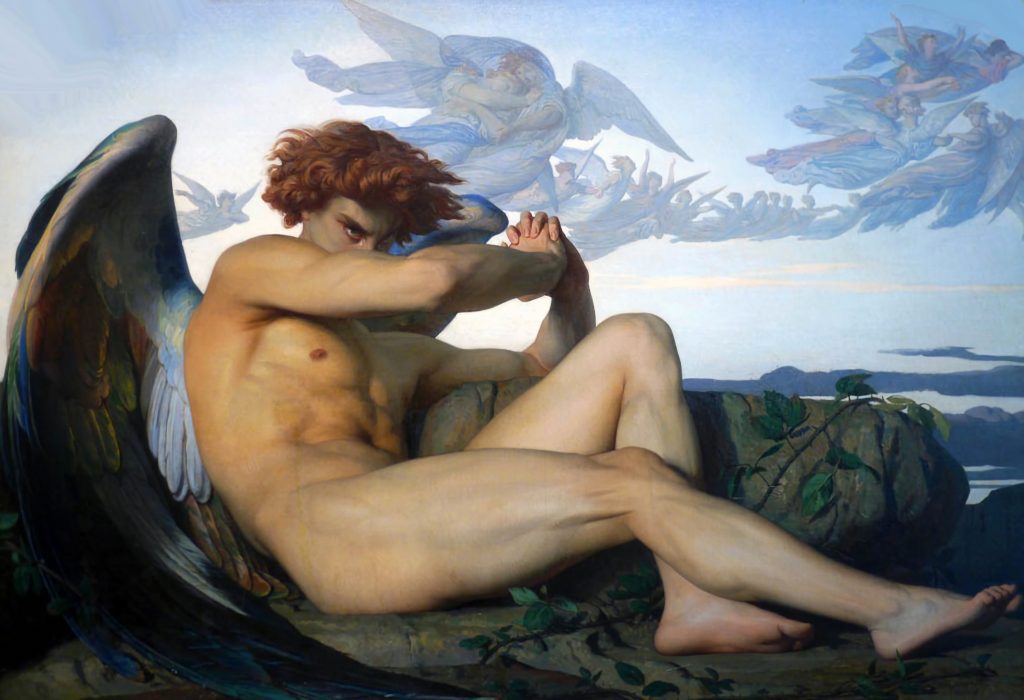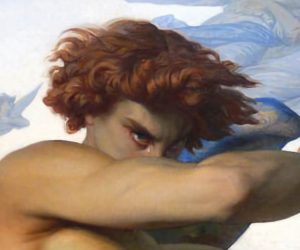Introduction
Alexandre Cabanel’s The Fallen Angel is one of those paintings that stops you in your tracks. At first glance, it’s simply a beautiful portrait of a young man, his expression tinged with emotion. But when you look closer, you realize there’s so much more going on. This painting is about the angel Lucifer, who fell from grace, about defiance, loss, and beauty all wrapped together.
Painted in 1847, The Fallen Angel is Cabanel’s interpretation of a powerful moment in religious mythology—the fall of Lucifer. Once an angel of light, Lucifer was cast out of heaven for his pride and rebellion. In this painting, Cabanel doesn’t just show a figure that’s been defeated; he captures the complexity of this iconic character, balancing between anger, sorrow, and pride.

Lucifer’s Appearance
The figure of Lucifer in this painting is youthful, with soft features and a perfectly sculpted body. His pose, with one arm draped across his knees and his head turned slightly, suggests a mix of emotions. What makes it so striking, though, are the eyes. His piercing gaze stares out from under furrowed brows, his eyes filled with a sharp intensity. They seem to burn with both hurt and defiance. There’s pain there, but also an unmistakable sense of rebellion. You get the feeling that while he’s been cast out, he’s not going down without a fight.
It’s not hard to see why this particular Lucifer painting has left such an impact on so many viewers over the years. Cabanel wasn’t just interested in painting a beautiful figure; he wanted to capture the inner turmoil of this moment. The choice to focus on Lucifer at the moment of his fall, rather than after or before, makes the painting all the more powerful. It’s that in-between state—no longer an angel, not yet the ruler of Hell—that Cabanel captures so well.
The angelic features of Lucifer—his delicate skin, golden hair, and soft wings—create an interesting tension within the painting. Here we have someone who has been condemned and is no longer welcome in heaven, yet he still retains the beauty and grace of an angel. It’s this tension between outward beauty and inner torment that makes the piece feel so dynamic. You can’t help but be drawn into the conflicting emotions swirling around the figure.
Light and Dark
Cabanel’s use of light and dark in this painting is another aspect that adds depth to the work. The soft, almost ethereal glow surrounding Lucifer contrasts with the darkness that seems to be creeping in. It’s as if the light of heaven is still clinging to him, but at the same time, shadows are starting to take over. The result is a visual metaphor for Lucifer’s fall—the transition from light to darkness, from grace to damnation.
Interestingly, the painting doesn’t show any clear signs of violence or punishment. Lucifer’s wings are still intact, and there’s no fire or chains to symbolize his fall. This makes the painting feel more psychological than physical. It’s not about the fall itself, but the emotional and spiritual consequences of it. Cabanel’s choice to keep the image so clean and refined gives it a certain elegance, even though the subject matter is dark.
What Emotions Does Lucifer Show in the painting?
One of the reasons why this Lucifer painting resonates with so many people is because of its portrayal of defiance. Even in his fallen state, Lucifer’s expression and posture suggest that he hasn’t given up. There’s a certain pride in the way he holds himself, a reminder that this is a figure who, even in defeat, refuses to submit entirely. It’s a powerful reminder of the human spirit as well—the idea that even when we fall, we can still hold on to our dignity and sense of self.
At the same time, there’s a vulnerability to the figure. His nakedness, while showcasing his beauty, also leaves him exposed. This is a being who has lost everything—his home, his place in the divine order, his identity as an angel. The combination of pride and vulnerability creates a complex emotional landscape that keeps viewers engaged. You can feel the weight of his loss, but also his refusal to fully accept it.
Comparison to Other Interpretations of Lucifer
Cabanel’s The Fallen Angel can be appreciated on so many levels. On one hand, it’s simply a stunning portrait, a showcase of the artist’s technical skill and ability to capture the human form. On the other, it’s a deep exploration of one of the most famous stories of rebellion and loss. The painting invites viewers to think about themes like pride, defiance, beauty, and the consequences of choices.
What makes this painting stand out among other depictions of the fallen angel is how human Lucifer feels. While he’s still clearly an angelic being, his emotions are so familiar. We’ve all experienced moments of loss, anger, and defiance in our lives. Cabanel taps into that universal experience, making the figure of Lucifer feel less like a distant myth and more like a relatable, if tragic, character.
Conclusion: The Famous Painting of Lucifer
In the end, The Fallen Angel remains a timeless piece because it goes beyond the surface. It doesn’t just show a beautiful figure or an iconic story. It captures a moment of intense emotion, one that’s still relevant today. We might not be angels cast out of heaven, but we all know what it’s like to face loss and struggle, to feel torn between pride and vulnerability. That’s what makes this painting of Lucifer so compelling—it’s a reflection of the complexities of human experience, wrapped up in a mythological tale.




